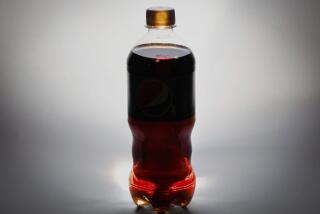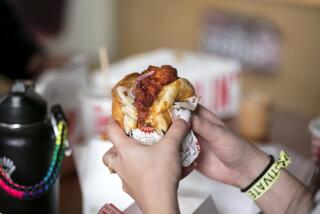Brain may read sugar substitutes
As the palette of artificial sweeteners has grown and manufacturers have honed the skill with which they blend them to mimic sugar taste, debate has swirled around whether these sensory stand-ins really help people consume fewer calories and avoid weight gain.
New research adds another dimension to the uncertainty: It suggests that even when artificial sweeteners fool the taste buds, they still donât fool the ultimate arbiter of our appetites -- our subconscious brains.
The latest evidence for this comes from a brain scanning study performed in the Netherlands. Paul Smeets, a neuroscientist at University Medical Center Utrecht, used a technique called functional magnetic resonance imaging (fMRI) to measure brain responses in people sipping two versions of orangeade, one containing sugar and one containing a mix of four artificial sweeteners: aspartame, acesulfame K, cyclamate and saccharin.
The mixture of artificial sweeteners was concocted to match the taste of real sugar as closely as possible. And the sugary and artificial drinks were administered on different days -- making it harder for the tasters to notice any difference between the two. Subjects often guessed wrong on which drink was which. âThey didnât know,â Smeets says.
Yet the fMRI scans revealed consistent differences in how their brains responded.
Both sugar and the noncaloric sweeteners activated a brain region called the amygdala, which signals sensory pleasure. But only the sugared drink turned on a cherry-sized nugget of brain tissue in a region called the caudate.
That little nugget, Smeets concluded, seemed to represent an unconscious perception of calories -- assessed quite separately from the sweet taste.
âWe think the brain can distinguish, even if the people themselves cannot distinguish, between a caloric and a noncaloric sweet drink,â says Smeets, who presented his results at the Human Brain Mapping meeting in San Francisco in June.
Brain-imaging experiments sometimes draw criticism for producing little more than colored spots on a brain map -- high-tech Rorschach ink blots that researchers may over-interpret according to their own biases. But another study, published earlier this year, suggests that Smeets is onto something.
Edward Chambers, an exercise physiologist at the University of Birmingham in Britain, compared the effects of sugar and artificial sweeteners on peoplesâ ability to do hard aerobic exercise -- and he found some striking differences.
Chambers has previously shown that the mere taste of sugar can improve endurance in athletes who have fasted for several hours. If the athletes rinse their mouth with sugared water but donât swallow any, it improves their performance in an hour-long cycling workout by a small but consistent amount. The apparent promise that sugar will soon reach the bloodstream provokes the cyclistsâ brains to drive their legs harder -- the same way that the promise of a paycheck in the mail motivates a cash-strapped student to go shoe shopping.
But when Chambers tried the same experiment with a mixture of the artificial sweeteners aspartame and saccharin, he saw no such effect. Tasting the artificial sweeteners didnât improve cycling speed, even though they tasted sweet.
Tasting a nonsweet sugar, maltodextrin (whose flavor was masked with aspartame and saccharin so it tasted the same), did improve cycling speed.
âThe sweetness is the conscious perception of the substance,â Chambers says. âBut there also appears to be this unconscious nutrient-sensing occurringâ in the mouth. Athletes couldnât consciously distinguish the sugared and nonsugared drinks, but their brains picked up the difference.
Chambers also did fMRI scans of his athletesâ brains. He found that the sugared mouth rinses strongly activated two reward centers in the brain, the anterior cingulate cortex and caudate, whereas the artificial sweeteners activated these brain areas only weakly -- similar to Smeetsâ results.
These studies heighten lingering questions about the usefulness of artificial sweeteners. Although some studies over the years have found that artificially sweetened foods and drinks reduce calorie consumption and weight gain, others suggest they might not.
âWe have some idea that in the short term thereâs calorie savingsâ with artificial sweeteners, says Adam Drewnowski, director of the Center for Obesity Research at the University of Washington in Seattle. âBut then people say that what you do today at lunch may not translate into saving pounds of body weight at the end of four weeks. So we need more studies.â
Research has shown that drinking an artificially sweetened beverage can whet the appetite and stimulate people to eat more in a subsequent meal -- an effect not seen when people drink a sugared beverage or glass of water before eating. It suggests that artificial sweeteners may turn on brain areas that create appetite, but not provide satiation. This might trigger people to eat a bigger lunch, says Guido Frank, a psychiatrist who studies eating disorders and brain responses to sweeteners at the University of Colorado at Denver. Frankâs brain imaging experiments have hinted as much.
In addition, some epidemiological studies find that people who regularly consume artificially sweetened drinks carry, on average, a few more pounds than people who donât.
But other studies have muddied the picture.
A small study published in 2007 found that artificially sweetened drinks trigger more eating only in people who donât drink them very often. People who habitually drink lots of artificially sweetened beverages didnât consume a larger meal after drinking one -- suggesting that their subconscious brains have adjusted to the sweeteners over time.
âThere is no 100% clear message,â Frank concludes. But, he adds, just as people are encouraged to keep an eye on their intake of real sugars, so should the dietary role of artificial sweeteners be carefully considered.
âIf you manage to replace all your sugar drinks with a combination of a glass of water, a can of diet soda and three carrots, that would be a good thing,â he says. âBut you could argue that using large amounts of artificial sweeteners is not really as helpful as one might think, because maybe you cannot really trick the brain. Maybe the body still gets the calories from somewhere else.â
One approach might be to avoid the zero-calorie drinks that crowd our grocery aisles in favor of reduced-calorie drinks that combine artificial sweeteners with real sugars. Such drinks might preserve the brainâs connection between sweetness and calories, Smeets says.
Or one might drink sugary drinks -- but more slowly. A study published earlier this year by Smeets found some merit to this advice. Smeets allowed his subjects to drink their fill of sugar-sweetened orangeade but strictly controlled the size of their sips using a pump. People drank less orangeade overall when their sip size was smaller.
The upshot, Smeets says, is that a low-tech solution might suffice -- for example, drinking through a thin straw rather than gulping, and avoiding artificial sweeteners altogether. Or, as Frank suggests, substituting a glass of cold water for that 44-ounce soft drink.
âThe ideal artificial sweetener would really fool the body,â Smeets says. âBut Iâm not sure that is possible.â
--
--
latimes.com/health
Even sweeter
They have that sugary taste with few or no calories to speak of. But what are they? Look online for our list of man-made and naturally derived sugar substitutes, including stevia, above.






